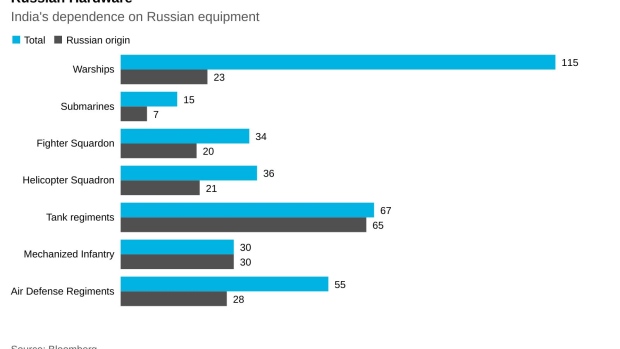Mar 20, 2022
India’s Dependence on Russian Weapons Tethers Modi to Putin
, Bloomberg News

(Bloomberg) --
For all the success of the U.S.-led campaign to isolate Russia on the world stage, India has stood out as one major democracy that has been reluctant to criticize Vladimir Putin -- and billions of dollars in weapons purchases mean that’s unlikely to change anytime soon.
Prime Minister Narendra Modi’s government is facing more pressure from fellow members of the Quad -- the U.S., Japan and Australia -- to help push Russia toward a cease-fire. After meeting Modi in New Delhi on Saturday, Japanese Prime Minister Fumio Kishida called for more cooperation between democracies while noting Putin’s war has “shaken the global order.” Modi, by contrast, only spoke on economic issues.
Modi is slated to hold a virtual summit on Monday with Australian Prime Minister Scott Morrison, while U.S. Undersecretary for Political Affairs Victoria Nuland -- who has helped coordinate the American response to Ukraine -- is expected to visit New Delhi later this week.
India, the world’s largest buyer of Russian weapons, plans to push back by arguing the purchases are necessary to counter China’s growing military assertiveness and its other neighbor, Pakistan. Modi’s government will also say the alternatives to Russian weapons are too expensive, according to people familiar with the situation, who asked not to be identified because they are not authorized to speak with the media.
India operates over 250 Su-30 MKi Russian-made fighter jets, seven Kilo-class submarines and more than 1,200 Russian-made T-90 tanks -- all of which are operational for another decade, the people said. In the pipeline are weapon systems worth about $10 billion that include a nuclear submarine to be leased to India and S-400 air defense system batteries.
India’s Ministry of Defense didn’t immediately reply to a request for comment outside of regular business hours.
“Despite efforts at diversification, India’s military hardware is still almost 70% Russian,” said Manjari Chatterjee Miller, a senior fellow for India, Pakistan and South Asia at the Council on Foreign Relations and author of “Why Nations Rise: Narratives and the path to Great Power.” India “has to continue to rely on Russia for parts, maintenance and upgrades,” she added.
The cost for India to replace all of its Russian-origin equipment is daunting. India’s entire defense budget for 2021-22 is $70 billion, and a long-delayed plan to procure 114 fighter jets to replenish its fleet and replace some older Russian fighters is estimated to cost India between $15 billion and $18 billion even if produced domestically, the people said.
“New Delhi also lacks options to replace military systems like air defense platforms it cannot easily get elsewhere,” said Ian Hall, professor of international relations at Griffith University and author of “Modi and the Reinvention of Indian Foreign Policy.”
While India has supported calls for a cease-fire and a diplomatic solution, it abstained at the United Nations on votes for draft resolutions condemning Russia’s invasion that were ultimately vetoed by Moscow. Still, so far the U.S. and its allies have sought to avoid an open rift with India: a joint statement after Quad leaders spoke in the wake of Putin’s invasion failed to condemn Russia.
That’s largely because India remains an important partner in countering China, particularly after deadly clashes along their Himalayan border prompted Modi to move more troops and Russian weapons to key hotspots. India has also changed laws to restrict Chinese companies and investment, banned over 300 China-affiliated mobile applications and cut back on visas for Chinese businessmen as the border standoff escalated.
“India is a really important security partner of ours now,” Donald Lu, assistant secretary of state at the Bureau of South and Central Asian Affairs, told a U.S. Senate committee on March 2 when asked whether India could face sanctions for buying Russian weapons.
“We value moving ahead in that partnership,” he added, noting that India had recently hit the brakes on more orders for Russian MiG-29 fighter jets, helicopters and anti-tank weapons. “And I hope that part of what happens with the extreme criticism that Russia has faced, is that India will find it’s now time to further distance itself.”
India is also keen to avoid Russia becoming even closer to Pakistan, which is more likely if Modi’s government joined U.S. allies in censuring President Vladimir Putin. India and Pakistan have fought three wars, and their militaries remain on high alert.
Pakistani Prime Minister Imran Khan last month led the country’s first delegation to Moscow in two decades just as Putin’s invasion got underway. Last year, Russian Foreign Minister Sergei Lavrov visited Pakistan as Moscow sought to increase its stature in the region, particularly in Afghanistan after the chaotic U.S. withdrawal.
Pakistan was the world’s eighth-largest weapons buyer in 2017-2021, with Russia accounting for a small fraction of imports. India is concerned that more acquisitions of Russian weapons could “provide Pakistan a qualitative advantage,” according to Richard M. Rossow, Wadhwani Chair in U.S.-India Policy Studies at The Center for Strategic and International Studies.
Still, India will find it hard to maintain a “truly neutral position” without alienating the U.S. and other Quad countries particularly because Russia has viewed New Delhi’s positions as “silent support,” said Miller of the Council on Foreign Relations.
“The Ukraine crisis is not a geographically confined regional European crisis that does not affect India,” she said. “It has implications for the future of the liberal international order.”
©2022 Bloomberg L.P.


